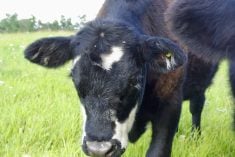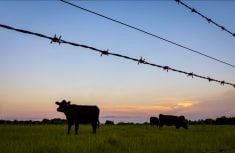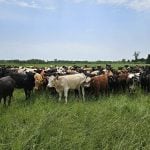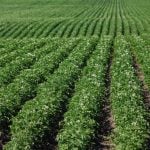Atypical Interstitial Pneumonia (AIP) continues to plague the beef industry in unpredictable ways. Also known as acute bovine pulmonary emphysema and edema, AIP is a common cause of sudden respiratory distress in cattle, particularly adult beef cattle grazing lush pastures through late summer and fall and in feedlot cattle through the finishing period. Sudden onset of clinical signs with minimal coughing and severe difficulty breathing characterize AIP. Affected animals often die despite supportive treatment. Those that do survive can improve dramatically over the course of several days.
Cases of AIP have been reported in west central Alberta and Saskatchewan during the summer of 2016. Rain and lush regrowth of fall grazing pasture and cropland will likely increase the risk of AIP.
Read Also

Body condition, nutrition and vaccination for brood cows
One of the remarkable events of the past century related to ranching has been the genetic evolution of brood cows….
Although AIP has been described in veterinary literature since the 1960s, many questions about inciting causes and the predictability of onset still exist.
Common features of the disease include:
- Nursing calves are seldom affected. Yearlings are less susceptible than mature cows.
- Sheep and horses are much less susceptible than cattle.
- Pastures of any sort (grass or legume) as well as annual crops (corn, sudan grass, etc.) can predispose to AIP. AIP also can be seen when animals preferentially graze lush growth in lowland meadows or water discharge areas, even if the remainder of the pasture is not exceptionally green.
- It is the “lushness” and “abrupt change” that seems important, not the forage species.
- Outbreaks usually develop within five to10 days of a change to better grazing and rarely occur after animals have been on a pasture field for three weeks or more.
- The highest incidence rate is in July and August.
- In feedlots, AIP outbreaks occur four times more frequently in heifers than in steers and often after cattle have been on feed at least 90 days.
- AIP appears to be associated with elevated acidity of the rumen (rumen pH greater than 6).
- No specific treatment for AIP exists at this time.
AIP is a multifaceted disease with several known causes and a range of clinical presentations. Multiple causes and management practices have been associated with development of AIP. The sporadic incidence and development of disease in a variety of circumstances suggests that common infectious agents are not generally involved, at least in mature cattle. In feedlots, however, most cattle dying of AIP have pre-existing lung disease caused by common respiratory pathogens.
It appears that the disease develops and progresses as a basic response to lung injury. Breakdown products of the naturally occurring amino acid l-tryptophan have been incriminated as triggering AIP. Metabolites like methylindole are absorbed into the bloodstream, carried to the lungs and become part of a toxic mix when they react with natural enzymes associated with gas exchange and breathing in lung tissue. The level of l-tryptophan can be high in lush, rapidly growing pastures, particularly in the fall. Although AIP and bovine respiratory syncytial virus (BRSV) produce similar lung pathology, BRSV has been ruled out an inciting cause of AIP. BRSV can cause respiratory death, but by a different mode of action than AIP. At one time, the research community considered AIP allergic in origin, perhaps a reaction to dust, but this too has been debunked.
Atypical interstitial pneumonia (AIP) or acute bovine pulmonary emphysema and edema are also known as fog fever, pulmonary emphysema, acute bovine respiratory distress syndrome and bovine asthma. Affected animals are often called “panters” or “lungers.”
Clinical syndromes vary. In feedlots, AIP typically affects calves that have been on feed for 90 days or more. Outbreaks have been reported in calves during hot, dry summers and occasionally in young calves recently introduced to a feedlot. AIP can appear following apparent recovery from respiratory infections.
Affected cattle on pasture are typically adults recently introduced to lush, rapidly growing cover crops. Outbreaks usually develop within five to10 days of a change to better grazing and rarely occur in animals that have been on pastures for three weeks or more. Calves, especially nursing calves, are seldom affected. Mild cases may go unnoticed, or cattle simply appear subdued, but alert with a noticeable rise in respiratory rate and effort when observed closely. Cattle with mild signs usually recover spontaneously within several days. Severely affected cattle show marked respiratory distress with mouth breathing, protrusion of the tongue, and drooling. A loud expiratory grunt is common, but coughing is unusual. Mild exercise increases the respiratory effort dramatically and may precipitate death. If death does not occur, many animals improve dramatically and resume eating by the third day. Some animals develop emphysematous crackles along the back as air from the thorax migrates under the skin. Some cattle have subcutaneous emphysema (air under the skin) extending from the withers along the entire back. Full clinical recovery may require three weeks. A classic lesion observed in animals that die is lungs that fail to collapse when the chest is opened. The lungs are congested and fluid filled. Large gas filled bulla (bubbles) and fluid occupy interstitial spaces between the alveoli (chambers) where air exchange normally takes place.
There is no treatment shown to be particularly effective. Supportive treatment with diuretics and anti-inflammatories may be beneficial. Producers should work with their veterinarians ahead of time to have treatment protocols in place and treatment materials on hand. Often, cattle may be affected so severely that handling or sorting them may cause them to collapse. In such cases, and since the treatments are probably only of marginal value, it is best to avoid prolonged forced movement. Instead, offer shade and comfort where the cattle are. Over two to three days, individual animals either recover or die.
Ionophores like Monensin offered in a free choice pasture supplement during the early days of being introduced onto new, lush pasture may help limit the risk of AIP. Dietary management involves limiting access to lush pasture.

















